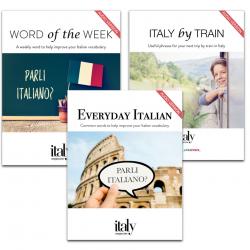Ferragosto
ITA:

The little mountain village in eastern Umbria that we moved to a year ago does not boast a huge population. In fact, the permanent inhabitants of the village number a mere 16!
Francesca, who has to be the most respected lady in the village (she holds the key not only to the churches in the village but to practically all the houses as well) once said to us ‘ci sono piu cani che Cristiani nel paese’ (there are more dogs than Christians (people) in the village).
Mass Exodus
The population takes a sharp upward turn during the Easter and summer holidays, particularly during the last two weeks of August when all but a few Italians take advantage of the Ferragosto (Feast of the Assumption) holiday and reclaim the Italian beaches and mountains, leaving the cities depleted and with only hot, pink-faced tourists remaining to endure the heat.
Last year we had heard about the summer ‘invasion’ but did not expect it to be such an amazing transformation of the quiet mountain village we know and love. From hearing only the bells from nearby Preci church and the bleating of flocks of sheep, we awoke one August morning to teenagers on motorini, children running us over on their bicycles (obviously in training for when they become 14 and can ride their motorini), countless cars and the accompanying jovial shouts of the families as they arrived in our hitherto peaceful village.
The initial shock faded into insignificance with the discovery of our village neighbours – families enjoying the fresh air, children free to play outside instead of being kept captive in city apartments, everyone catching up on the gossip since last year’s reunion and we began to enjoy the merriment.
Celebrations
One evening we went with my visiting in-laws to the local festa in Preci and had an unexpected encounter with the local mechanic, chef and waiter – they were all up on the stage giving a very impressive performance of the ‘Full Monty’!
Rehearsals had clearly been taken seriously and the audience thoroughly enjoyed it - apart from one man standing next to me. His hand covered his eyes and upon enquiring after his well-being I learnt that one of the performers was his son!
On the evenings of Ferragosto itself we were made to feel like guests of honour, one evening at the Spaghettata, with vast quantities of delicious spaghetti in a tomato sauce, and then the next at the Salcicciata, with local sausages grilled and produced bruschetta-style on bread on the big communal barbecue.
These both took place in the main village square, an extended terrace with superb views over the park and the pretty village of Preci. We were not allowed to contribute to the food, wine or barbecue as we were the new arrivals being welcomed by the entire village.
This August we are actually looking forward to the arrival of the village-ex-pats, maybe because we know that all the festivities and activities only last for two short weeks and then the village reverts to its peaceful and tranquil setting... and we are lucky enough to be able to enjoy the best of both these magnificent worlds. italy

Il paesino di montagna nella parte orientale dell’Umbria nel quale ci siamo trasferiti un anno fa non vanta una numerosa popolazione. Infatti gli abitanti residenti nel paese arrivano al mero numero di 16!
Francesca, che è la signora più rispettata nel paese (tiene non solo la chiave di tutte le chiese del paese ma praticamente anche di tutte le case) una volta ci ha detto ‘ci sono piu cani che Cristiani nel paese’.
Esodo di Massa
La popolazione ha un’impennata durante la Pasqua e le vacanze estive, particolarmente durante le ultime due settimane di Agosto quando tutti, eccetto pochi Italiani, approfittano della festività del Ferragosto (Festa dell’ Assunzione) e si riappropriano delle spiagge e delle montagne italiane, lasciando le città vuote e con solo accaldati turisti dalla faccia pallida rimasti a resistere il caldo!
L’anno scorso avevamo sentito parlare dell’ ‘invasione’ estiva ma non ci aspettavamo una tale sorprendente trasformazione del quieto paese di montagna che conosciamo e amiamo! Dal sentire solo le campane della vicina chiesa di Preci e il belare delle greggi di pecore, ci siamo svegliati una mattina di Agosto con giovinastri sui loro motorini, ragazzini che ci venivano addosso con la bici (ovviamente in allenamento per quando potranno guidare i motorini all’età di 14 anni), innumerevoli automobili e le grida gioviali delle famiglie che li accompagnavano mentre arrivavano qui nel nostro pacifico paese.
L’impatto iniziale è sfumato via con la scoperta dei vicini del nostro paese – famiglie che si godono l’aria fresca, ragazzi liberi di giocare fuori invece di essere tenuti imprigionati negli appartamenti di città, tutti che si aggiornano circa le chiacchiere dell’ultimo raduno dell’anno prima e abbiamo cominciato a goderci il divertimento.
I Festeggiamenti
Una sera c’è stata la festa del posto a Preci e quando siamo andati con i miei parenti che mi facevano visita abbiamo avuto un inaspettato incontro con il meccanico, il cuoco e il cameriere del luogo – erano tutti sul palcoscenico impegnati in un bello spettacolo di spogliarello.
Le prove erano chiaramente state prese seriamente e il pubblico s’è divertito molto – tranne un uomo che stava vicino a me. La sua mano copriva i suoi occhi e dopo avergli chiesto se stava bene ho saputo che uno degli spogliarellisti era suo figlio.
Nelle sere di Ferragosto stesso ci hanno fatto sentire come ospiti d’onore, una sera alla Spaghettata con vaste quantità di deliziosi spaghetti con salsa di pomodoro e poi la sera dopo con la Salcicciata, con salsicce del posto grigliate e hanno preparato pane tipo-bruschetta sulla grande grigliata in comune.
Questo è accaduto sia nella piazza principale del paese, una estesa terrazza con una superba vista sul Parco e anche nel bel paese di Preci. Non ci è stato permesso di contribuire al cibo, vino o alla grigliata in quanto eravamo i nuovi arrivati che venivano accolti dall’intero paese.
Ora, con l’estate che si avvicina velocemente, non vediamo l’ora che arrivino le lunghe calde serate quando dividiamo il nostro giardino con le belle lucciole e questa volta, in realtà, aspettiamo con gioia l’arrivo degli ex-residenti del villaggio,, forse perchè sappiamo che tutte le feste e le attività durano solo due brevi settimane e poi il paese ritorna al suo pacifico e tranquillo stato... E siamo abbastanza fortunati di poter godere del meglio di entrambi questi magnifici mondi.











